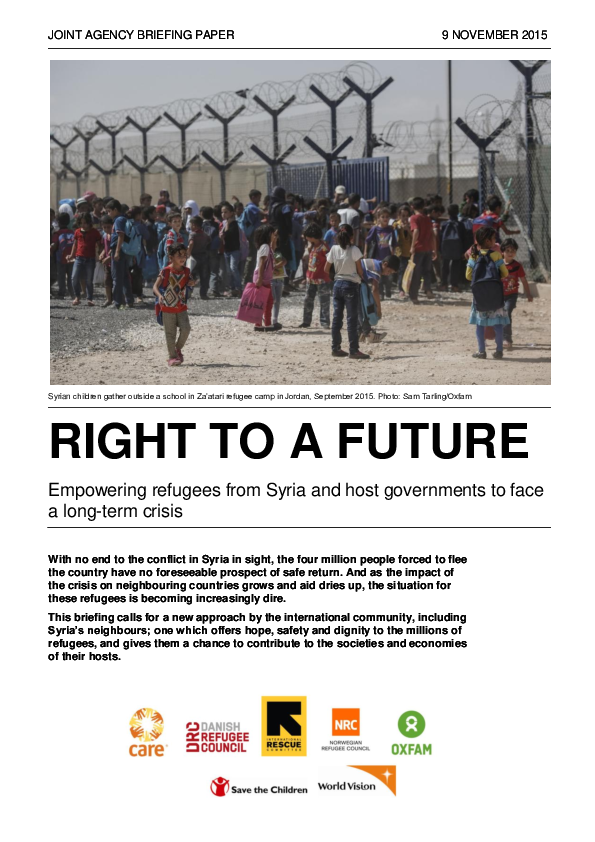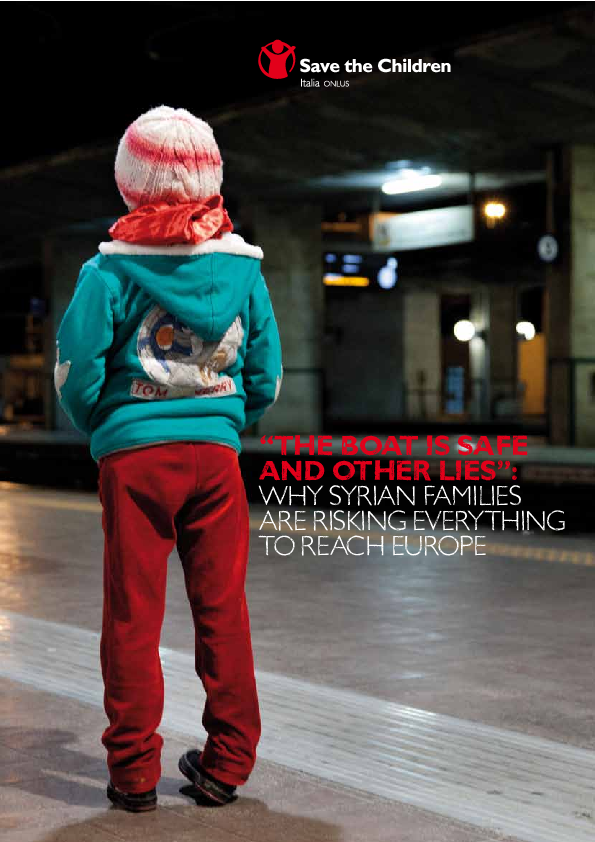Children on the move: At risk beyond borders
Share:
Currently, the world is seeing one of the largest movements of refugees in recent history. An estimated 60 million people in the world are on the move; 30 million of them are children. The movement itself poses many risks to children, but on top of the immediate risks of injury and death, lack of essential services can have detrimental impacts on child development and well-being. Children are on the move, both within and between countries and with or without their parents. Children on the move, especially unaccompanied children, are at high risk of abuse, exploitation, violence and trafficking. Along with the immediate risks, secondary effects of displacement such as poor living conditions and the lack of education also have deep impacts on children’s psychological well-being. This is shown in the recent report Childhood in the Shadow of War produced and written by Save the Children. The report brings insight into the daily life of Syrian child refugees living in the host countries of Lebanon and the Kurdistan region of Iraq, as well as the experiences of internally displaced (IDP) Iraqi children.
The majority of the world’s 60 million refugees look for protection in neighbouring countries. Most Syrian refugees, for example, have sought safety in countries like Turkey, Jordan and Lebanon, while Pakistan and Iran host the majority of Afghan refugees. During 2015, over one million people have reached Europe, according to IOM, the majority after having made the dangerous journey crossing the Mediterranean Sea, fleeing war, conflict, persecution and poverty. More than 3,770 people have died or are missing in the attempt to cross the Mediterranean in 2015, but it is still uncertain how many of them were children.
Read more about Save the Children’s response to the deepening child refugee and migrant crisis in Europe.
The current winter conditions make the journey even more dangerous. The latest data released from IOM shows that more than 360 refugees and migrants died in January 2016, which is more than four times higher compared to the same period last year. IOM estimates that 60 of the deaths were of children below the age of 18. At the same time as new pictures of dead children on the shores of Turkey appear in the media, more and more European countries seek to restrict the number of arrivals of migrants and refugees.
The violent conflict in Syria has forced over 4.3 million Syrians to leave the country and has left 6.5 million people displaced within the country. Children are telling Save the Children staff that they have witnessed their friends and families being killed in front of them. Their homes are now rubble. Many have been tortured. They are hungry, often sick. Millions of families inside Syria and in neighbouring countries cannot access adequate life-saving assistance such as food, shelter and healthcare. Exposure to violence and lack of essential services can have enormously detrimental impacts on child development and well-being. From the very beginning of the crisis in Syria, children have been the forgotten victims, facing death, suffering and trauma, and deprived of basic humanitarian aid. According to the film Psychological impacts of war on Syrian children, produced by Save the Children, one in four children inside Syria are at risk of developing a mental health disorder.
Those children and families who manage to escape encounter other problems. Movement increases the risk of separation from family members, something that can have a profound effect on children’s safety, development and psychological well-being. The refugee camps give families some kind of roof over their heads, but offer few opportunities for the adults to earn an income. The recent Save the Children report Childhood in the Shadow of War shows that the stress that comes from a constant concern for meeting basic needs can permeate whole households, which in turn may lead to alcohol abuse and violence against family members. Economic realities and/or gender-based violence in the camps are leading some families to marry off their daughters, since they feel they can no longer provide for them neither protect them from abuse. Staff in Za’atari refugee camp in Jordan, one of the largest refugee camps in the world, report that the rate of child marriage has more than doubled since the influx of refugees began.

Childhood in the Shadow of War
2015 · Save the Children Sweden
Now in its fifth year, the armed conflict in Syria continues to increase in intensity. More and more civilians are being driven from their homes to seek safe shelter elsewhere in... View Full Abstract
“Because of harassment from boys we cannot leave the tents alone. We must be accompanied by our fathers or brothers to go anywhere, even to the store or the child friendly space.” 15 year old girl, IDP camp, Iraq (Childhood in the shadow of war)
Tension between refugees and host community members are reportedly common. Children report feeling inferior to other children in the host communities and experience verbal and physical harassment:
“Other children talk to me in a very bad manner using bad words. They point at me as a Syrian dog and say we are the ones who are exploding the country.” (Psychological impacts on war on Syrian children: Aden)
Many children have missed several years of education and worry about the many barriers in their lives to achieving their dreams – their families’ economic conditions and the lack of quality educational opportunities. Some girls may not go back to school at all because of economic burdens. Experience in other conflict settings where Save the Children works shows that the longer children are out of school, the less likely they are to ever go back. Long-term poverty in the refugee population will deny more and more children their childhood and threatens their future. In the video clip 6 Voices from Za’atari, made by the Swedish Magazine Barn, Omar, 17, and Hiba, 18, in Za’atari refugee camp in Jordan describe the hopelessness and idleness they feel, when the future is so uncertain and life is put on pause:
”We lived in a village called Muhajjah. We had five rooms and a kitchen and bathroom. When we left Syria, we didn’t bring anything. We were just strongly committed to save our lives. We only got the clothes that we were wearing with us. When I first came here, there were no schools. I had to wait one year before I could start school. What I did? Went out of the tent. And in again.” Omar, 17
”Now I have started studying for graduation again and I’m so scared of losing one more year of my life. After everything that has happened I try not to plan so much, so I would not get disappointed. I realize that anything could happen – I can return to Syria and I can be forced to leave the country again. I expect everything and nothing.” Hiba, 18
Some of the psychosocial symptoms among refugee children are sadness, anger, worry, fear, anxiety, nightmares, alcohol and drug use, self-harming behavior, bedwetting, speech disorders and behavioral changes such as aggressive behavior.
During this time of crisis, Save the Children is providing children with psychosocial support by creating Child Friendly Spaces in the camps and in host communities. Individual and group therapeutic sessions are available, as well as non-formal education services intended to improve self-confidence and building life skills. Save the Children is also supporting parents and working with local host communities and leaders.
Save the Children advocates for legal routes to Europe and we work along the whole route that refugees take. In addition to psychosocial support we also help by providing food, water and housing, mother-and-child spaces, drop-in centres, and transit care.
Featured Resources
7 resources
Share
Link






